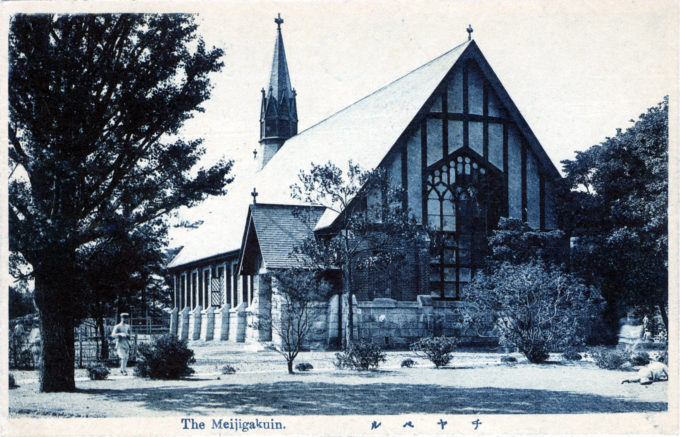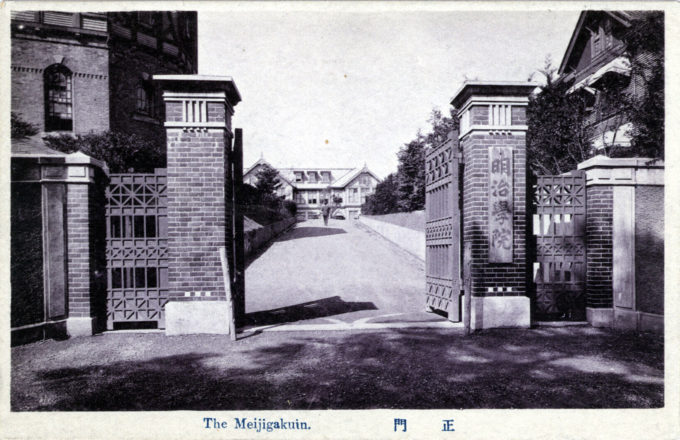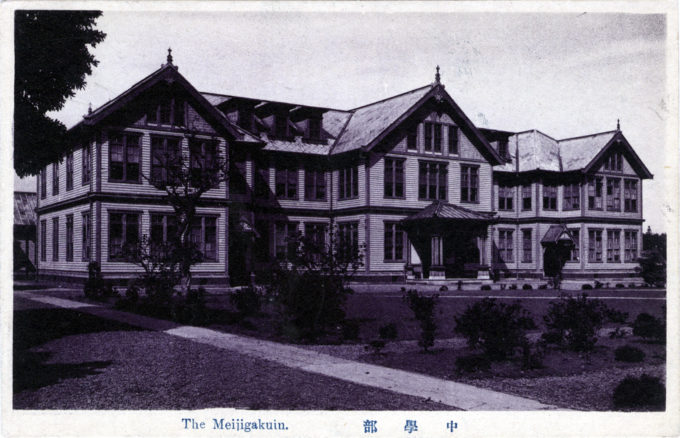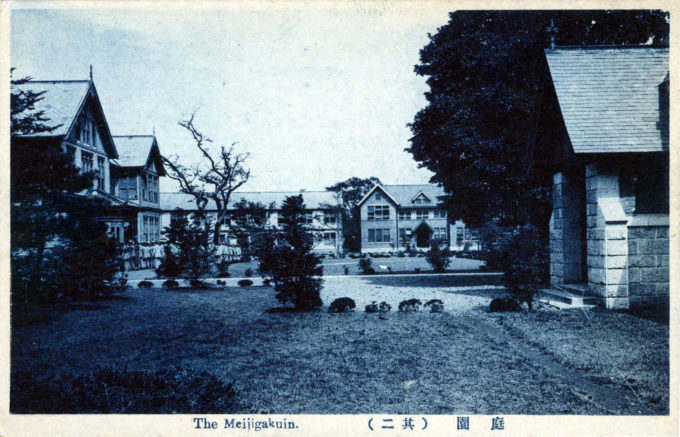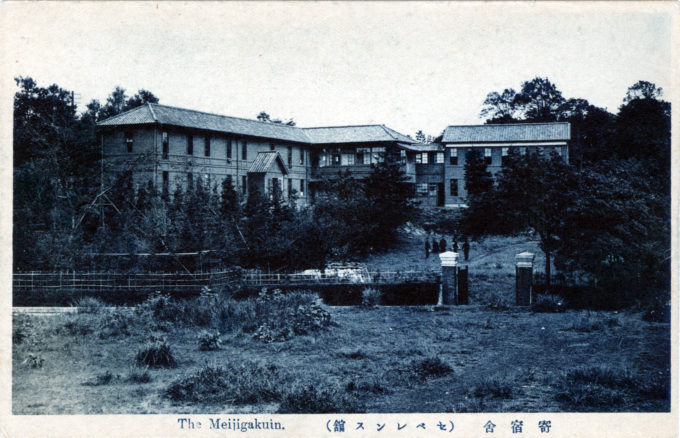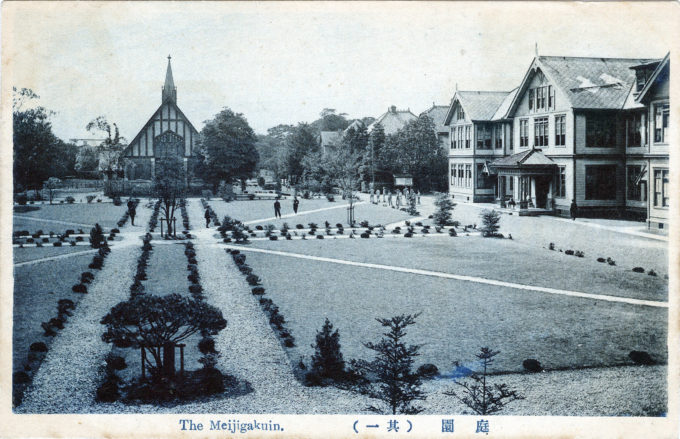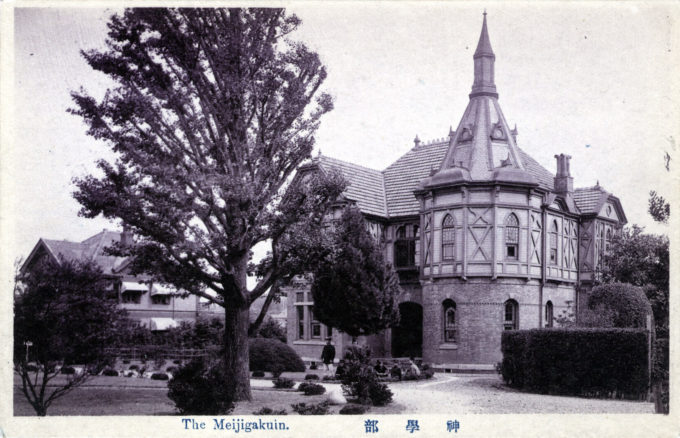
Memorial Hall (former Theological School), Meiji Gakuin University, Shirokane, Tokyo, c. 1920. Damaged by an earthquake in 1894, the second floor was rebuilt in a half-timber style.
See also:
Rikkyo (St. Paul’s) University
Meiji College, c. 1920-1930
Tokyo Imperial University, c. 1930
Waseda University, c. 1910
“Meiji Gakuin University traces its origin back to the Hepburn Academy founded in 1863 by Dr. James Curtis Hepburn, the disseminator of the Hepburn system of Japanese romanization (first published in 1867), the Brown Academy and the Verbeeck Academy, all of Yokohama. The academies consolidated into the United Japanese-English Theological School and moved to the Tsukiji foreign settlement in 1880, taking the name Tsukiji Dai Gakko [Tsukiji College]. The college assumed the name ‘Meiji Gakuin’ in 1886 and, in 1887, the Tokyo government approved a move of its campus from Tsukiji to its present location at Skirokane, Tokyo. Hepburn was appointed the first president of Meiji Gakuin.
“At its new location, the former Theological School was first built in 1890, based on plans [by William Merrell Vories] sent from the United States. It accommodated not only classrooms and a library but the residence also of the school president.
“The building sustained damage in an earthquake in 1894. The second floor was then built in a half-timber style, atop the brick structure of the first floor. Toson Shimazaki (1872-1943), the poet and novelist (The Broken Commandment [Hakai], 1906; Before the Dawn [Yoakemae], 1929-1935), was among the first students to pass through this hall. (Toson also wrote the lyrics of the school song.)
Chapel, Meiji Gakuin University, c. 1920. Designed by William Merrell Vories, who also created the popular ointment ‘Mentholatum’.
“… [The architect] Vories, born in Leavensworth Kansas, was educated at the University of Colorado in the United States. He first came to Japan in 1905. He is probably best known in Japan for founding a missionary enterprise that produces an ointment called ‘Mentholatum‘.
“Although Vories had no formal architectural education, he had an active architectural practice as well. Other works by him include the Doremus School and Hilltop Hotel. Vories eventually became a Japanese citizen and took on his wife’s family name, Hitotsuyanagai.
“This brick-construction chapel with an impressive truss ceiling is an early work by him. The transept was a later addition.”
– “The Architecture of Tokyo, by Hiroshi Watanabe, 2001
- Main gate, Meiji Gakuin, c. 1920.
- Meiji Gakuin campus, Middle School, c. 1920.
- “The Garden”, Meiji Gakuin campus, c. 1920.
- H.L. Severance Hall (dormitory), Meiji Gakuin campus, c. 1920.
“The Union Theological School was organized in September, 1877, by the missions of the Presbyterian Church in the United States of America, the Reformed Church in America, and the United Presbyterian Church of Scotland. The Union College was organized in June, 1883, by the missions of the American Presbyterian and the Reformed Churches.
“In June, 1886, these institutions were united, and, with the Special Department then organized, became the Meiji Gakuin, i.e., “College of the Era of Enlightened Peace.” In this new institution the Union Theological School became the Japanese Theological Department, the Union College the Academic Department, and the Special Department offered instruction through the medium of the English language in theology and other special studies to the graduates of the Academic Department and to others similarly qualified.
“… The institution is located at Shirokanemura, a southern suburb of Tokyo, about one mile northwest of the railway station at Shinagawa. Sandham Hall, Hepburn Hall and Harris Hall contain recitation rooms sufficient for four hundred students, with a library, besides dormitory and dining-room accommodations for one hundred and fifty boarders. Harris Hall was erected through the liberality of Messrs. G. S. Harris & Sons, of Philadelphia. A theological hall was built in 1891, a commodious chapel in 1904, and a dormitory for theological students in 1908.”
– Historical Sketch of the Missions in Japan, Published by the Board of Foreign Missions of the Presbyterian Church, 1910
“The Meiji Gakuin in Tokyo is a college for young men, the only Presbyterian institution for boys and young men in Japan. It is a union school supported by the Presbyterian and Dutch Reformed churches and is an institution of which we may justly be proud.
“It is beautifully located in one of the finest parts of the city of Tokyo, is well housed and splendidly equipped. There are three departments: The middle school with 310 students, the college with twenty-five students, and the theological department with twenty-five young men studying for the gospel ministry. Dr. Ibuka, a Japanese, is the President, a position which he has filled with marked ability for more than twenty years. He is one of the preeminent Christian leaders of Japan, and stands in the very forefront as an educator.
“The missionary force in the school are, Dr. Imbrie, Mr. Landis, Mr. Ballagh, and Mr. Reischauer. These are all strong men and are doing a most excellent work in this important institution. They are assisted by a large and capable faculty of Japanese teachers. The college and seminary have sent out many strong men who have contributed to the progress and Christian development of Japan.
“The Meiji Gakuin is one of the few mission schools which has secured government recognition. This gives it a standing in the country and enables its graduates to compete with those of the Imperial schools on an equal basis.”
– Around the World: Studies and Stories of Presbyterian Foreign Missions, Published by the Missionary Press, 1912


